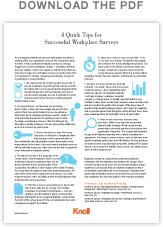
As a workplace professional you have valid insights into what is working within your organization and how the workspace needs to evolve. A well constructed workplace survey can strongly support your case for workplace change — providing more than “just your opinion,” even if your opinion is well-informed. Here are some tips to make your workplace surveys successful, taken from our experience in creating, managing and analyzing surveys for organizations in many industries.
1. Be prepared to do something with the results. If you ask employees to go through the exercise and then do nothing with it, you’re guaranteed to disappoint them, and discourage them from participating next time. If you do surveys regularly, be sure to routinely recognize outcomes and convey that you’re working together toward solving issues.
2. Set expectations. Just because you are asking about a topic, it does not mean people will get what they want (or think they want). Explain that you are gathering information about employee workspace needs in order to set the broader direction for the workplace and to inform the design and planning process. Note that although the data will be carefully reviewed, not every issue will be addressed, and not at a person-by-person level.
3. Gather the data in a way that keeps responses confidential. If employees think their answers can be connected back to them individually, they will probably answer dishonestly or skip large portions of the survey. If you must match employee names or identity with their responses, make sure that the data is reported in a way that protects employee privacy.
4. Provide the survey in the language of the survey-taker. At multi-nationals, when it comes to decisions about the workplace there can be tension between the US-based portion of the organization and offices in other regions of the world. Providing the survey-taker the option to select the desired language at the start of the survey shows respect for local cultures, can vastly improve response rates, and helps ensure that all employees fully understand the survey questions.
5. Offer the survey to all employees in the facility that will be affected by change. Do not allow employees to self-select to participate — only very satisfied, very dissatisfied or highly communicative employees will respond. To encourage participation, communicate the intent of the survey ahead of time, and emphasize that senior management supports the initiative.
6. Keep the survey as short as possible – 10 to 12 minutes to complete. Frequently many people are involved in the survey development process. Too many cooks in the kitchen can lead to overly long surveys. Sometimes a question makes it into the survey because someone thinks the answers will be interesting. Ensure that each question could lead to an actionable outcome.
7. Answers to survey questions should be primarily “countable” items, with some openended responses. Use a standard five-point response scale for most questions (typically 1=strongly disagree, 2=disagree, 3=neutral, 4=agree, 5= strongly agree, or parallel “very dissatisfied to very satisfied” scales). Seven and ten point response scales are rarely used and do not add to the quality of the analysis. While these types of questions help quantify employee opinion, don’t forget the qualitative side. Let people express their thoughts in writing through two or three open-ended questions that add depth to the numerical data.
8. Have human resources review survey questions. While it may seem like just another internal hurdle, involving HR will ensure that the survey does not include questions that could put the organization at legal risk. This is especially important in large multi-nationals operating with a variety of employment agreements. For instance, some countries, such as Germany, have specific employee privacy laws that will influence the way questions are asked and the way data may be reported. Getting HR on board early on can increase the visibility of your survey, the validity of your effort, and the response rate.
Employee surveys are a great tool to understand employee satisfaction with the workplace and readiness for change. Done correctly, surveys can be a part of a successful workplace change experience. Done poorly, they can heighten employee anxiety or set unrealistic expectations for a new workspace. Following these general tips will greatly increase your chances for success and give your employees the voice they expect in their evolving workplace.
DOWNLOAD "8 QUICK TIPS FOR SUCCESSFUL WORKPLACE SURVEYS" TO READ THE FULL PAPER





















